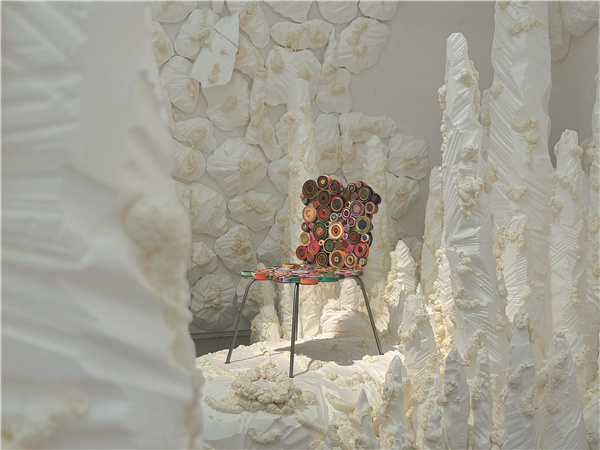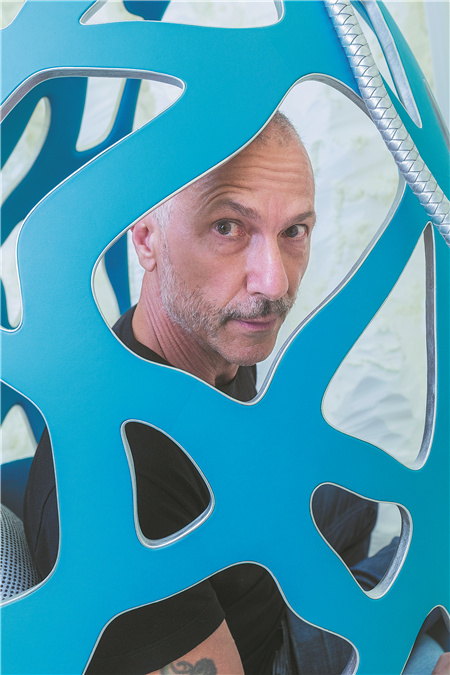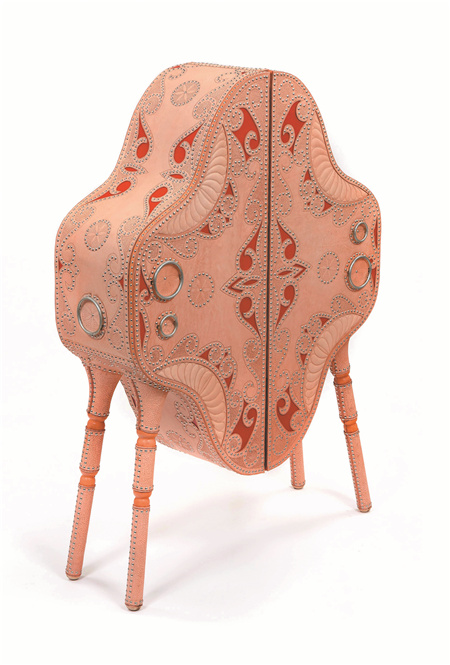
The Art of Magic Made from Leftovers

An installation on display at the Impermanence — 40 Years of Estudio Campana exhibition in Shanghai from June 8 to Sept 8. [Photo by He Qi/China Daily]
Shanghai show is largest exhibition of legendary Brazilian designers' work in Asia, He Qi reports.
From a chair pieced together out of countless dolls that has been bought by many fashion celebrities; to a chair made of broken wood blocks which inspired the design of the Brazil Pavilion at the 2010 Shanghai World Expo; to another chair made by twining 500 meters of red thread around its frame which is part of the collection of the Museum of Modern Art in New York, behind all these eye-catching pieces are the legendary design duo from Brazil — brothers Humberto and Fernando Campana.
Founded in 1984, Estudio Campana has achieved international recognition for its intriguing furniture design.
In collaboration with the power station of DESIGN at the Power Station of Art, the studio is presenting Impermanence — 40 Years of Estudio Campana in Shanghai from June 8 to Sept 8, its first large-scale exhibition in Asia.
Fifty pieces take visitors into the duo's fantasy world, tracing the history of their ideas and creations.
"This is our first large-scale exhibition in Asia, and it is a new challenge for us, as well as a new process of exploring our inner world and inner universe," says Humberto Campana, who designed the exhibition's scenography.
Marco Sammicheli, co-curator of the exhibition and the curator for Design, Fashion, Crafts at the Triennale Milano, says that Estudio Campana has demonstrated the possibility of connecting decoration and value, function and fiction, culture and nature over its 40-year career.

Humberto Campana [Photo provided to China Daily]
"The work of the Campana brothers has transformed contemporary design. They were the first to intuit the richness of hybridizing creativity by giving dignity to scraps, waste and less noble materials so that the objects could portray and attest to desires: the ethics of recycling, the dignity of artisan work, the forgotten aesthetics of rural and indigenous Brazil, the madness of colors and shapes in the domestic landscape, the hybridization between production systems and environmental awareness," he adds.
Deeply rooted in Brazilian culture and tradition, the studio's work, which ranges from furniture to architecture, landscaping, fashion, and scenography, carries universal values at its core, such as freedom and human dignity, creating their identity through life experiences.
The pieces have been taken from the permanent collections of cultural institutions such as the Centre Pompidou and the Musee des Arts Decoratifs in Paris, and MoMA in New York.
After Fernando passed away at the age of 61 in 2022, Humberto was determined to honor his brother's legacy and the projects they undertook together and committed to continuing with plans for the expansion of the activities of the Instituto Campana, and the Estudio Campana.
"My relationship with Fernando has always been and continues to be transcendental. Our connection from the moment of his birth until his departure only reinforces the fact that his physical presence was just a brief meeting of souls on this planet, and it is my mission to continue telling our stories and proposing new ways of living life," Humberto Campana says.
To take visitors on their creative journey from childhood to the early stages of their careers, a Cabinet of Curiosities contains never-before-displayed personal objects, original drawings, and prototypes.

Cangaco Cabinet. [Photo provided to China Daily]
To provide a nest for the curators' vision, Humberto Campana has designed an alluring structure of artificial stalactites and stalagmites, a reference to Plato's "Allegory of the Cave", where visitors can roam freely and discover the pieces as they materialize from behind organically shaped columns, like a game of hide-and-seek.
"I wanted to combine the curators' work with a child-like experience, which for me is the most accurate way of explaining how my brother and I trailblazed through life: by taking steps into dark, unknown territories, and shedding light on our explorations and findings. Plato's classic allegory is something we can all relate to, at any age or from any background," Humberto Campana says.
"I like to think we are all born curious, and this scenography is an invitation to embrace estrangement, to step away from your comfort zone, and be rewarded by the courage to let imagination run free in an adventurous search for joy," he adds.
Archival footage is also being shown, including contemporary ballet productions and TV specials, such as the story of Vermelha, the ground-breaking chair created in 1993 that became the duo's most recognized and best-selling piece.

Cartoon banquet chair. [Photo provided to China Daily]
In parallel, Estudio Campana was commissioned to produce two new pieces: an installation for the museum's atrium, entitled Astro, a 12-meter-high hanging tulle sculpture inspired by the images generated by the Hubble Space Telescope.
Pyro, another installation made to inaugurate PSA's Sky Garden and created in collaboration with Chinese garden designer Yuan Zheng, is an oversized cluster of bamboo and steel structures fully integrated with graceful landscape design, which resemble star bursts and dot the space that looks onto Shanghai's skyline.
The 2,000-square-meter rooftop was opened at the same time as the exhibition.
"I am honored to have the opportunity to design this installation for the city of Shanghai. I wanted to create a space for celebration and joy with sculptures resembling fireworks, with the beautiful skyline as the backdrop. It is a nod to nature and architecture as being integral to our future on this planet," says Humberto Campana.
If You Go
Impermanence — 40 Years of Estudio Campana
June 8 — Sept 8, 2024
Tuesday-Sunday, 11 am-7 pm (last admission at 6 pm).
Power Station of Art, 678 Miaojiang Road, Huangpu district, Shanghai.